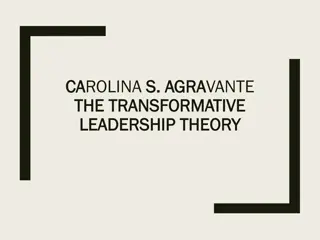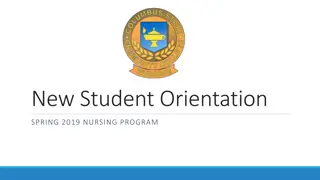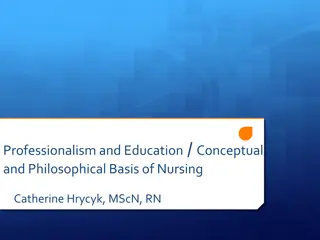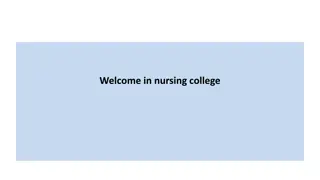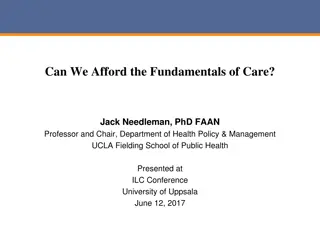Understanding Nursing Theory and Science Essentials
Nursing theory plays a crucial role in strengthening the nursing profession by providing a foundation for reasoning, critical thinking, and decision-making. The metaparadigm of nursing encompasses key concepts such as person, environment, health, and nursing philosophy. Different levels of theory, including conceptual models and frameworks, provide structure and clarity in understanding nursing phenomena. The scientific method guides quantitative, qualitative, and mixed methods research, while basic, clinical, and translational science contribute to advancing knowledge and practice in healthcare.
Download Presentation

Please find below an Image/Link to download the presentation.
The content on the website is provided AS IS for your information and personal use only. It may not be sold, licensed, or shared on other websites without obtaining consent from the author. Download presentation by click this link. If you encounter any issues during the download, it is possible that the publisher has removed the file from their server.
E N D
Presentation Transcript
Introduction to Nursing Theory and Science Catherine Hrycyk, MScN, RN
Why Is Theory Important? Nursing as a profession is strengthened when nursing knowledge is built on sound theory. Theory is a useful tool for reasoning, critical thinking, and decision making (Tomey and Alligood, 2010). 2
Definitions Metaparadigm is the most abstract aspect of the structure of nursing knowledge (March and McCormack, 2009). The metaparadigm of nursing consists of the major concepts of the discipline person, environment, health, and nursing. A philosophy is a set of beliefs about the nature of how the world works. A nursing philosophy puts together some or all concepts of the metaparadigm. 3
Definitions A conceptual model or framework is a more specific organization of nursing phenomena than philosophies. Model or framework provides an organizational structure that makes clearer connections between concepts. Theories are more concrete descriptions of concepts that are embedded in propositions. Propositions are statements that describe linkages between concepts and are more prescriptive; that is, they propose an outcome that is testable in practice and research. 4
Science and Scientific Method Scientific method systematic way of thinking Quantitative research Qualitative research (naturalistic inquiry or interpretivism) Mixed methods combination of qualitative and quantitative Bias refers to systematic distortion of a finding from data, often resulting from a problem with the sample. 6
Science and Scientific Method Basic, clinical, and translational science: Pure science summarizes and explains the universe without regard for whether the information is immediately useful generates new knowledge Applied science practical application of scientific theory and laws also known as clinical science Translational research conduit between bench research and bedside research 7
Science and Scientific Method Inductive reasoning the process begins with a particular experience and proceeds to generalizations Inferences are made that lead to further research. Deductive reasoning a process in which conclusions are drawn by logical inference from given premises. It proceeds from the general case to the specific. Valid rather than true 8
Limitations of Strict Definition of Scientific Methods in Nursing The scientific method, as implemented exclusively with quantitative techniques, has limitations when applied to phenomena of interest to nursing. Health care settings are not comparable with laboratories. Human beings are far more than collections of parts that can be dissected and subjected to examination or experimentation. The claim for objectivity (freedom from bias) 1. 2. 3. 9
Nursing Research: Improving Patient Care Nursing research systematic investigation of phenomena related to improving patient care A problem may be amenable to being addressed by research if: A conceptual framework exists or can be constructed from previous research. The problem fits logically and aligns with what is already known. Based on related research findings published in professional, peer- reviewed journals or is supported by similar ongoing research in other settings Carefully designed. The results will be applicable in similar situations or will generate hypotheses for further research and testing. 10
Evidence-Based Practice Definition: An approach to the delivery of healthcare that integrates: 1. Best evidence from studies, 2. Patient care date with clinician expertise, and 3. Patient preferences (Melnyk, Fineout-Overholt, Stillwell, et al., 2009 p. 49). 11
Evidence-Based Practice Evidence-based practice is an element of critical thinking and a good means of improving clinical judgment. Focusing on evidence of effective interventions helps prevent nursing practice from deteriorating into routine or traditional care. Ways to stay current and aware of new evidence: Continuing education courses, professional conferences, journals, and membership in professional organizations Essential component of nursing education. Why? 12





